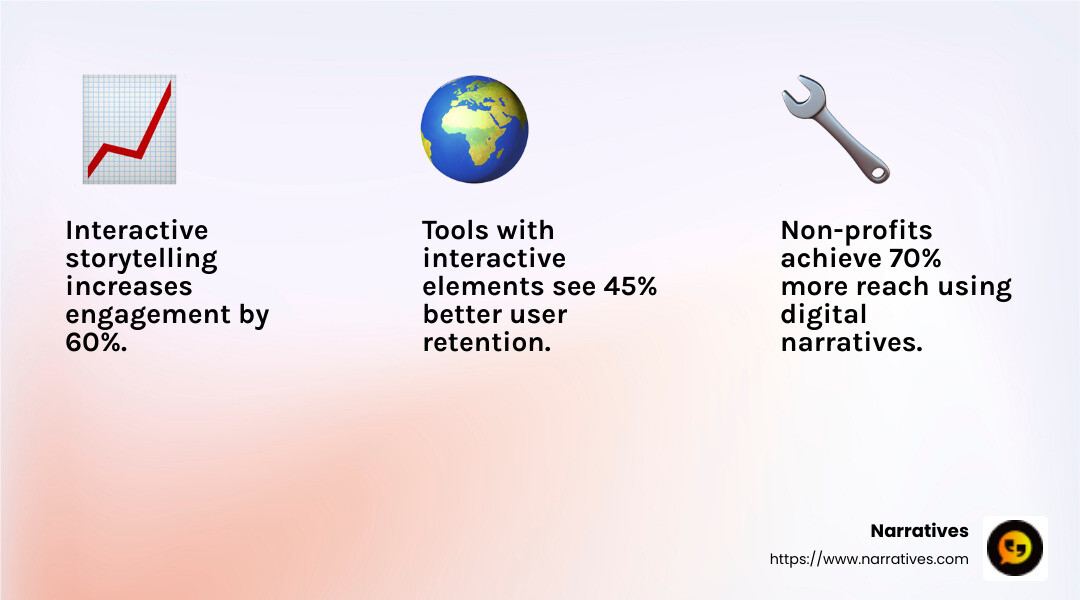Toolbox Tales: Best Interactive Digital Tools for Storytelling

Interactive digital tool to tell a story can transform dry information into an engaging narrative mix. With digital storytelling, multimedia content becomes a canvas, allowing organizations to weave videos, images, and interactive elements into their messages. This approach breaks the confines of traditional text, drawing in viewers with dynamic, immersive experiences.
Here are some top tools for interactive digital storytelling:
- TimelineJS - Craft interactive timelines easily.
- StoryMapJS - Build map-based linear narratives.
- Canva - Design stunning visual content.
- Piktochart - Create engaging infographics.
- Twine - Develop interactive narratives without coding.
In today's content-rich world, standing out is crucial, especially for non-profit organizations and social impact initiatives. By leveraging interactive digital storytelling, you can amplify your mission and foster deeper connections with your audience, whether they're potential donors or community supporters. It's about changing passive viewers into active engagers, making your storytelling not just informative but truly impactful.

Easy interactive digital tool to tell a story glossary:
- interactive digital storytelling examples
- interactive storytelling app
- interactive storytelling software
Interactive Digital Tool to Tell a Story
In storytelling, immersive storytelling is the magic ingredient that turns ordinary narratives into extraordinary experiences. It's about pulling your audience into the heart of the story, making them feel, see, and even shape the journey.
Interactive elements are key to achieving this. They transform viewers from passive observers into active participants. With tools like Inklewriter, users can make choices that dictate the story's direction. This branching narrative technique makes each experience unique and personal.
Multimedia experiences take this a step further by combining text, images, videos, and sound to create a rich, engaging mix. For example, Vimeo's interactive video feature allows creators to embed clickable hotspots. This means viewers can explore different paths within a video, making each viewing session a new trip.
These tools are not just about entertainment. They offer practical benefits too. For instance, educators can use platforms like Canva to create visual content that improves learning. Meanwhile, marketers can use ThingLink to craft interactive images that boost engagement.
The evolution of digital storytelling tools has opened up a world of possibilities. It's no longer just about telling a story—it's about crafting an experience. By using these tools, organizations can connect with their audiences on a deeper level, turning storytelling into a powerful tool for impact and engagement.
Top 5 Interactive Digital Tools for Storytelling
StoryWeaver
StoryWeaver is an interactive storytelling platform that offers a seamless way to craft and share stories across different channels. It excels in omnichannel marketing, allowing creators to reach their audience wherever they are, whether on desktop, mobile, or social media. This platform provides tools to integrate various media forms, ensuring stories are not just told but experienced.
VisualNarrate
VisualNarrate brings stories to life through interactive films. With its intuitive drag-and-drop interface, users can easily assemble multimedia elements to create dynamic narratives. This tool is perfect for filmmakers and content creators looking to engage audiences with a visually rich experience. By allowing viewers to interact with films, VisualNarrate makes storytelling more immersive than ever.
MediaBlend
For those who want to mix different media types, MediaBlend is the go-to tool. It offers mixed media editing capabilities that let users combine text, images, audio, and video into a cohesive story. One standout feature is its geolocation of content, which adds a layer of context by allowing stories to unfold based on the viewer's location. This makes it ideal for travel bloggers and journalists.
TimeMap Creator
TimeMap Creator specializes in creating timelines and story mapping. It's perfect for historical narratives or any story that unfolds over time. Users can plot events on a timeline, enriching them with multimedia content. This tool is especially useful for educators and historians looking to illustrate complex timelines in an engaging way.
BranchWriter
BranchWriter focuses on branching narratives that put the reader in control. Its user-centric design empowers storytellers to create paths that diverge based on user choices. This makes every story unique and personalized, providing an interactive experience that keeps audiences engaged. It's a favorite among game developers and authors who want to explore multiple story outcomes.
These tools demonstrate the power and versatility of an interactive digital tool to tell a story. By incorporating multimedia and interactive elements, they transform traditional storytelling into a dynamic experience. Whether you're an educator, marketer, or content creator, these platforms offer the resources to craft stories that captivate and engage.
How to Choose the Right Interactive Digital Tool
Choosing the right interactive digital tool to tell a story can feel overwhelming. But breaking it down into key factors can make the process much simpler. Let's explore the essentials: story needs, audience platforms, and user experience.
Story Needs
First, think about what your story requires. Is it a simple narrative or a complex multimedia experience? For example, if your story involves a historical timeline, a tool like TimeMap Creator may be ideal. It allows you to plot events and enrich them with multimedia content. On the other hand, if your story is more about branching narratives, then BranchWriter could be the right fit, as it lets you create multiple story paths based on user choices.
Audience Platforms
Next, consider where your audience spends their time. Are they more likely to engage on mobile devices, desktops, or social media? Tools like StoryWeaver excel in omnichannel marketing, ensuring your story reaches your audience wherever they are. By understanding your audience's preferred platforms, you can choose a tool that optimizes the storytelling experience across those channels.
User Experience
Finally, user experience is crucial. A tool might have all the features you want, but if it's not intuitive, it won't serve your needs. Look for tools with user-friendly interfaces. VisualNarrate, for example, offers a drag-and-drop interface that makes assembling multimedia elements easy, even for beginners.

The right tool should also support the flow of your story. If you're creating an interactive film, VisualNarrate can make the process seamless. For mixed media stories, MediaBlend provides the flexibility to combine text, images, and video, enhancing the storytelling with geolocation features.
By focusing on these key factors—story needs, audience platforms, and user experience—you can choose the right tool to craft compelling, interactive stories that capture your audience's attention and imagination.
Frequently Asked Questions about Interactive Digital Tools
What are digital storytelling tools?
Digital storytelling tools are platforms that help you weave stories using multimedia and interactive elements. These tools allow creators to combine text, images, videos, and audio to craft engaging narratives. They enable storytellers to create experiences where readers can interact with the story, making it more immersive and memorable.
By integrating multimedia, these tools transform traditional storytelling into rich, dynamic experiences that captivate audiences and hold their attention longer.
How can non-profits benefit from digital storytelling?
Non-profits can leverage digital storytelling to create a social impact by highlighting their mission and the communities they serve. Through community-driven storytelling, non-profits can bring attention to important issues and inspire action.
For example, a non-profit focused on environmental conservation might use digital storytelling to showcase the impact of climate change on local habitats. By using visuals and interactive elements, they can engage supporters more effectively than through traditional methods. This approach not only educates but also fosters empathy and encourages community involvement.
What features should I look for in a storytelling tool?
When selecting a storytelling tool, consider its scalability and adaptability. As your stories grow in complexity, you’ll need a tool that can expand with you. Look for platforms that allow easy updates and integrations.
Another key feature is the ability to incorporate interactive elements. Whether it's through clickable hotspots, branching narratives, or multimedia content, these features can significantly improve user engagement.
Lastly, prioritize tools that offer robust analytics. Understanding how your audience interacts with your content can provide valuable insights, helping you refine your storytelling strategy for maximum impact.

By focusing on these features, you'll be better equipped to choose a tool that not only meets your current needs but also adapts to future storytelling endeavors.
Conclusion
At Narratives, we believe that stories have the power to transform perspectives and inspire action. Our mission is to be the go-to partner for non-profits and purpose-driven organizations, helping them tell their stories in a way that truly resonates.
Non-profit partnerships are at the heart of what we do. We collaborate with organizations to lift underrepresented voices and shed light on important social issues. By crafting emotionally resonant content, we aim to build trust and increase visibility for these causes.
Through the use of interactive digital tools, we help non-profits share their impact stories in a more engaging and meaningful way. Whether it's through multimedia content, immersive storytelling, or community-driven narratives, our approach is designed to inspire and foster empathy.
For those looking to make a difference, digital storytelling is a powerful tool. By choosing the right platform, non-profits can amplify their message, reach a wider audience, and drive positive change.
To learn more about how we can help your organization share its story, visit Narratives. Let's work together to create content that not only informs but also inspires action.


